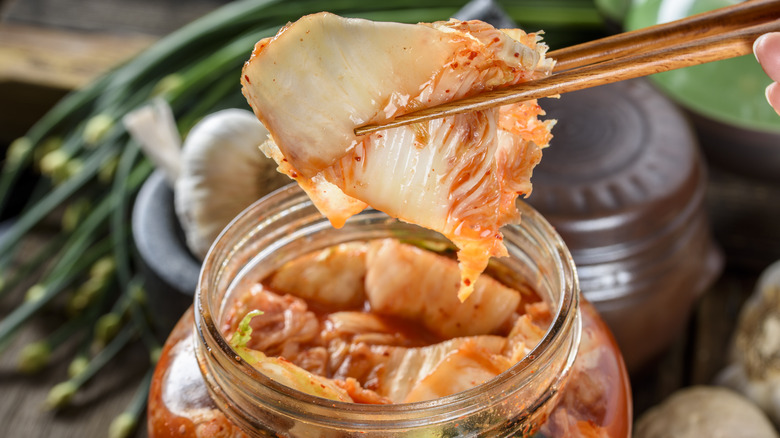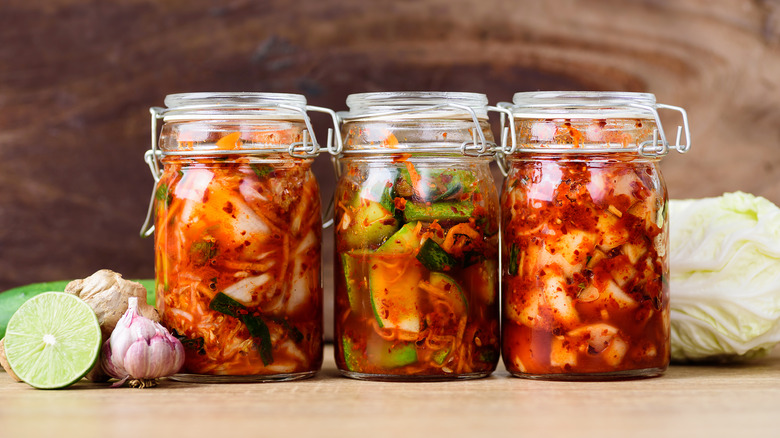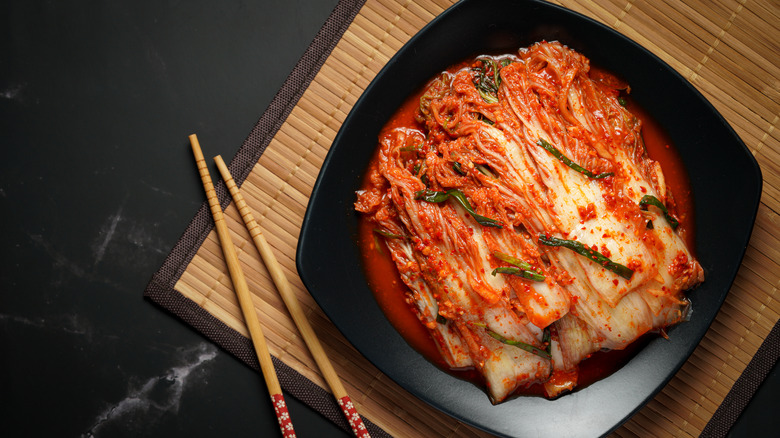The Bubbly Way To Tell If Your Kimchi Is Fermenting Correctly
As a delicious and spicy superfood, what's not to love about kimchi? Good for your gut and fun to make at home, this fermented cabbage condiment has only continued to become more popular stateside. According to the Fermentation Association, kimchi sales are increasing by 90% as people across the U.S. discover its gut-health benefits, versatility, and compelling sour flavor. Of course, the reason why kimchi is so packed full of those beneficial probiotics is due to the process required to make it — fermentation. And where there's fermentation, there's fizz and plenty of bubbles.
So how do you ferment kimchi? Well, you only need a few simple ingredients including cabbage, Korean chili flakes, carrot or radish, fish sauce, and optionally, small salted shrimp. Then you put it all in a jar, mash it up to release the water from the cabbage, add salt, make sure you have an airtight seal, and you're good to go! The kimchi actually does all the fermentation by itself. And how do you know your kimchi is fermenting correctly? According to Jin Kimchi, if it's bubbling, you're on the right track!
The more bubbles the better
How many bubbles are you looking for? The fizzier the better. According to Jin Kimchi, this is because, during fermentation, the good bacteria release carbon dioxide gas. So, more bubbles equal more bacteria eating more carbohydrates and making more lactic acid (the stuff that gives kimchi that tangy, umami flavor). Bubbles in kimchi are so important that celebrity chef David Chang even adds 7UP to his recipe!
Because of the creation of gases during the fermentation process, you will need to burp the jar. This means opening it about once a day to release the gas. Otherwise, the pressure may build up to the point of exploding. NPR also recommends that you stir the kimchi when you open it and make sure you get as much gas out as possible before closing it again. Other signs that your kimchi is fermenting correctly include that it has a sour taste and an acidic, vinegary scent.
What if there are no bubbles?
If there are no bubbles in your kimchi, that's a pretty strong sign that it is not fermenting correctly. This means that something went awry during the process, but don't worry too much! There are a few easy ways to fix the common mistakes that prevent fermentation.
Firstly, make sure that you are using the correct container. According to Revolution Fermentation a glass jar with a metal or plastic lid is the easiest and cheapest option. If you want to spend a bit more you can buy an airlock lid, which is specifically designed for fermentation and lets out the gas without allowing in any outside air. This way you don't have to burp the jar and will expose the fermenting kimchi to fewer outside germs.
If you have a good container and your kimchi doesn't have any visible mold, check the brine. Brines that don't have enough salt won't allow the good bacteria to beat out other microorganisms and start the fermentation process.
Once you've successfully fermented your kimchi, there are plenty of fun and creative ways to eat it including on a kimchi burger or even in a dish of mac n' cheese!


